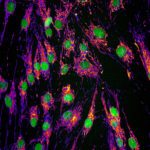Link to Pubmed [PMID] – 25683716
Cell Rep 2015 Feb;
Human SCO1 fulfills essential roles in cytochrome c oxidase (COX) assembly and the regulation of copper (Cu) homeostasis, yet it remains unclear why pathogenic mutations in this gene cause such clinically heterogeneous forms of disease. Here, we establish a Sco1 mouse model of human disease and show that ablation of Sco1 expression in the liver is lethal owing to severe COX and Cu deficiencies. We further demonstrate that the Cu deficiency is explained by a functional connection between SCO1 and CTR1, the high-affinity transporter that imports Cu into the cell. CTR1 is rapidly degraded in the absence of SCO1 protein, and we show that its levels are restored in Sco1 mouse embryonic fibroblasts upon inhibition of the proteasome. These data suggest that mitochondrial signaling through SCO1 provides a post-translational mechanism to regulate CTR1-dependent Cu import into the cell, and they further underpin the importance of mitochondria in cellular Cu homeostasis.

